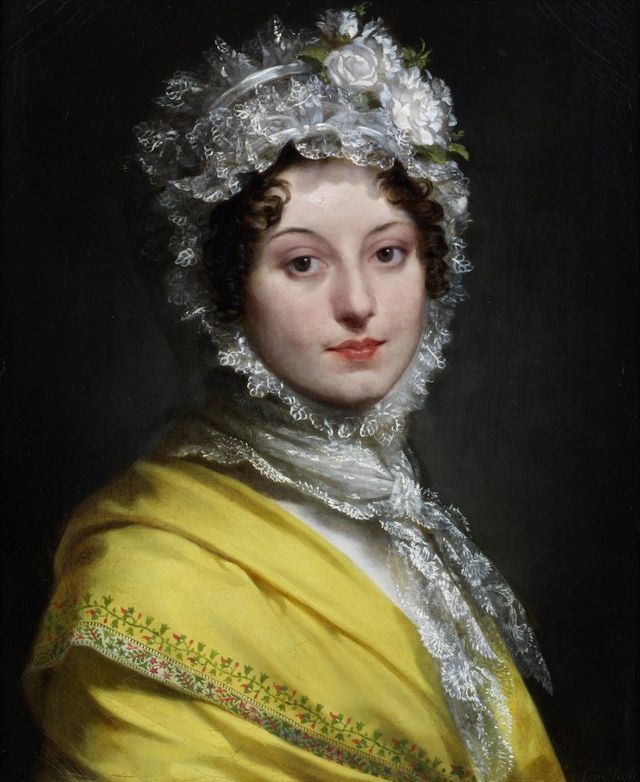The 19th century cap was a modest necessity. Worn by “spinsters” and “matrons” both young and old, it neatly covered a lady’s hair while she was at home and abroad. At face value, such a basic article of clothing seems to have changed little throughout the century. However, a closer look at the fashionable caps of women of the 1800s reveals that styles did in fact subtly evolve. Through lace, ribbons, and trimmings, ladies of the age continually reinvented the cap, transforming it from what might otherwise have been a merely utilitarian scrap of fabric into a fashionable, feminine confection that said as much about a woman’s personal style as her French bonnets, cashmere shawls, and India muslin gowns.
Caps of the early 19th century are loosely divided into three basic styles: the lace cap, the draped cap, and the mob cap. The lace cap and draped cap are fairly self-explanatory, with the latter being composed of fabric that drapes back from the face, over the head, and down the shoulders rather like a flowing veil. The mob cap is a large soft hat which covers all of the hair and is typically bordered by a broad ruffle or decorative frill. There is some crossover between these three varieties of caps. For example, mob caps might be composed, at least partly, of lace. An 1800 issue of The Lady’s Magazine reports, “The mob cap, cut into points, and richly ornamented with lace, is a late modest invention.”
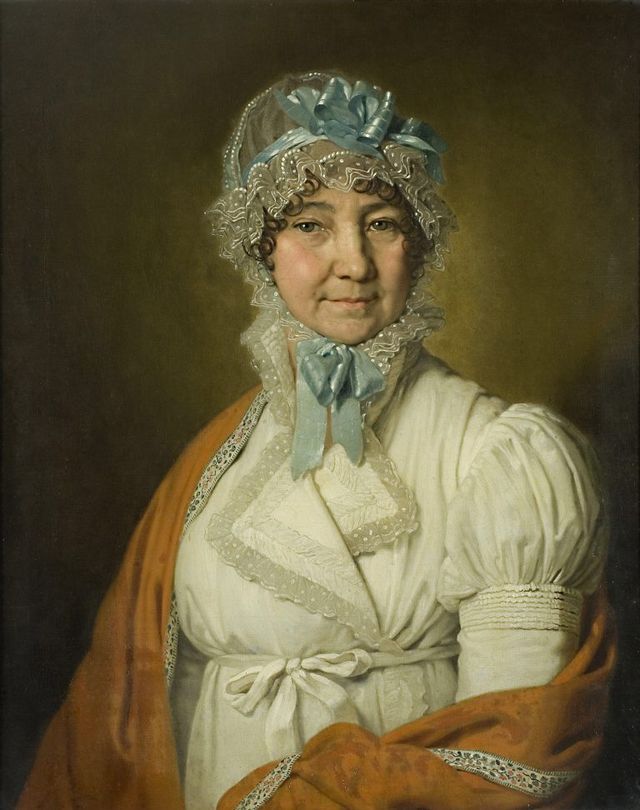 Portrait of Nadezhda Dubovitskaya by Vladimir Borovikovsky, 1809
Portrait of Nadezhda Dubovitskaya by Vladimir Borovikovsky, 1809
And in the 1817 account of Princess Charlotte’s wedding clothes, provided by Hone’s Authentic Account of the Royal Marriage, amongst the Princess’s millinery, we see the following itemization:
Six elegant English lace caps, trimmed with the most beautiful English laces that could be procured.
Two Valenciennes lace caps trimmed with Valenciennes lace, forming a coronet round the top, which has a very pretty effect.
A Brussels point lace mob cap, with beautiful rich trimmings of point lace.
A very superb cap of Brussels point, quite a new shape: this cap is most elegantly trimmed with a point, and the new double-sided satin ribbon.
A Mechlin lace cap, beautifully trimmed with Mechlin lace, and lined with white satin.
An elegant Mechlin lace mob cap lined and trimmed.
But just because a lace mob cap looked well on Princess Charlotte was no reason to think it would be becoming to the average early 19th century lady. By 1820, new variations of the three basic styles were introduced, made to flatter a range of face shapes and sizes. According to an 1820 issue of The Ladies’ Monthly Museum:
These caps are, in general, of the cornette, that is to say, mob-shape; but, as mobs do not become everybody, and as round caps are not comme il faut in undress, a style of cap has lately been introduced, which partakes a little of the form of both; and which is called a demi-cornette. Undress caps are, therefore, at present, of the cornette and demi-cornette kind. –The first are most in favor with the oval-faced belle, the latter is generally adopted by those ladies whose round or full faces render a mob-cap unbecoming to them.
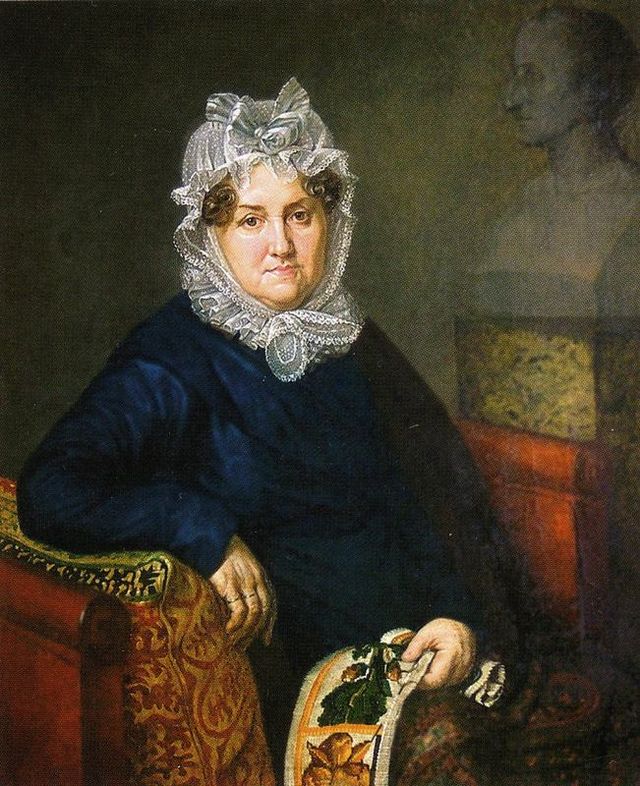 Portrait of Elizaveta Olenina by Alexander Varnek, 1820
Portrait of Elizaveta Olenina by Alexander Varnek, 1820
These variations on the mob cap were generally composed of fine muslin and trimmed with narrow lace. The cauls (the circle of fabric that covers the back of the head) were always low, with some “quartered like an infant’s cap” and others decorated with “puffs of muslin let in.” The Ladies’ Monthly Museum goes on to state:
The majority are ornamented with embroidery at each side of the caul; and a few caps, made of cambric muslin, or perkales, as the French call it, have the cauls so covered with embroidery, that you can hardly discover the materials of which they are made.
As for the cornettes and demi-cornettes:
The cornettes have the ears, in general, cut small, and placed very far back; they just meet under the chin, where they fasten with a bow of riband; the demi-cornettes also fasten under the chin with a riband; the head-pieces of both are of a moderate breadth, and there is always a full border of lace, which goes all round, and is frequently double, and even sometimes triple, over the face.
This double and triple full border of lace served a specific purpose, being generally worn by ladies whose “large and harsh features” rendered it necessary for them to “study how to throw a little softness into their countenances.”
 Mrs. Thomas Linley by James Lonsdale, 1820
Mrs. Thomas Linley by James Lonsdale, 1820
For 1820, caps worn at home, such as breakfast caps, might be trimmed with “knots or cockades of riband, or close wreaths made of riband, or rosettes composed of a mixture of riband and lace.” Flowers, however, were never worn in complete dishabille. The authority for this? The French, of course! As The Ladies’ Monthly Museum declares, “I am sure, in this respect, all my fair readers will agree with me, that French taste is correct.”
You will note that I have mentioned a distinction between caps worn at home and caps worn out of doors. There are many today who believe that caps were only worn in the home. This is untrue. Caps were worn outside underneath a lady’s bonnet or hat. They were also worn with full dress, though naturally the style of cap worn whilst eating your breakfast would not be the same style of cap worn for an evening at the theater. An 1829 issue of La Belle Assemblée reports the changes in fashionable caps for the season, as well as the differentiation between those caps for home costume and those for full dress:
Caps for home costume, and for half-dress, are now more of fine lace than of blond. They are certainly too large, especially when worn at dress dinner-parties, yet the style in which they are made is truly elegant: the lace, which is of a cobweb fineness, is beautifully intermingled with the puffs of satin ribbon, which is generally of pink, marsh-mallow-blossom, or some other lively tint; a few ornaments of ribbon tie on the hair, from where the lace turns back, and a loop-string of the same ribbon descends over the breast. A cap of fine lace, for home costume, is made something in the same style, but the lace is narrower, the cap smaller, and the border falls over the hair; bows and ornaments of ribbon adorn the crown, and two long lappets of lace float over the shoulders. The blond caps for the theatre, and other evening spectacles, are made with very broad, full borders of rich blond. These turn back, and a half wreath of flowers is placed underneath, lying on the hair.
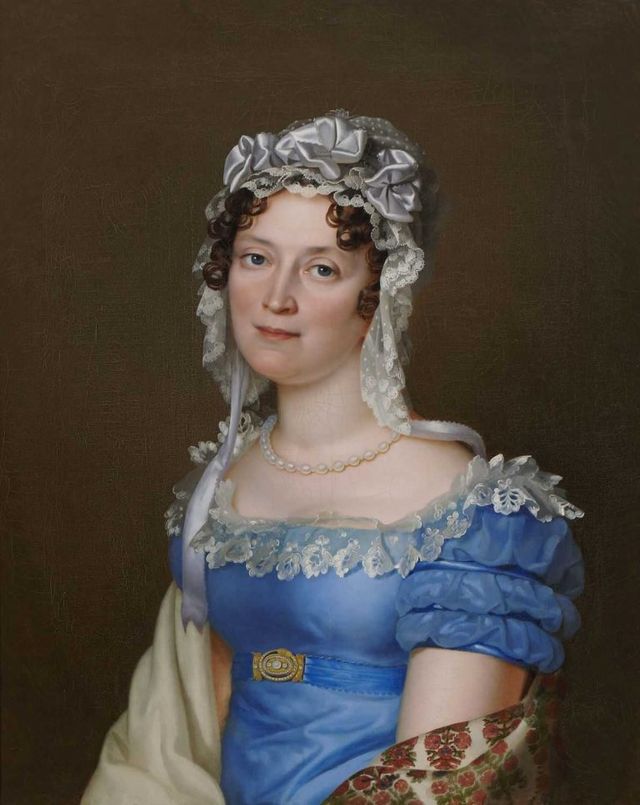 Princess Catherine of Wurttemberg by Franz Seraph Stirnbrand, 1820s
Princess Catherine of Wurttemberg by Franz Seraph Stirnbrand, 1820s
In the early 1830s, caps made of blond lace were all the rage for evening dress, though English lace was still “not as fashionable as it ought to be.” As for home dress, the 1832 publication Maids, Wives, & Widows declares:
The prettiest are of plain tulle, with the trimming of the front turning back as usual at the sides, but partially descending in the center of the forehead, where it is crossed by a bandeau of ribbon, which terminates in a full knot behind the trimming on one side. A very light knot composed principally of ends is placed on the trimming in the front.
During this time period, Maids, Wives, & Widows reports that a “neat and close style” of morning cap was gradually superseding the “winged edifices” whose borders were “more appropriate to full dress than to dishabille.” And that “We see with pleasure that British washing net, of extreme fineness and clearness, begins to be used by very genteel women for morning caps.”
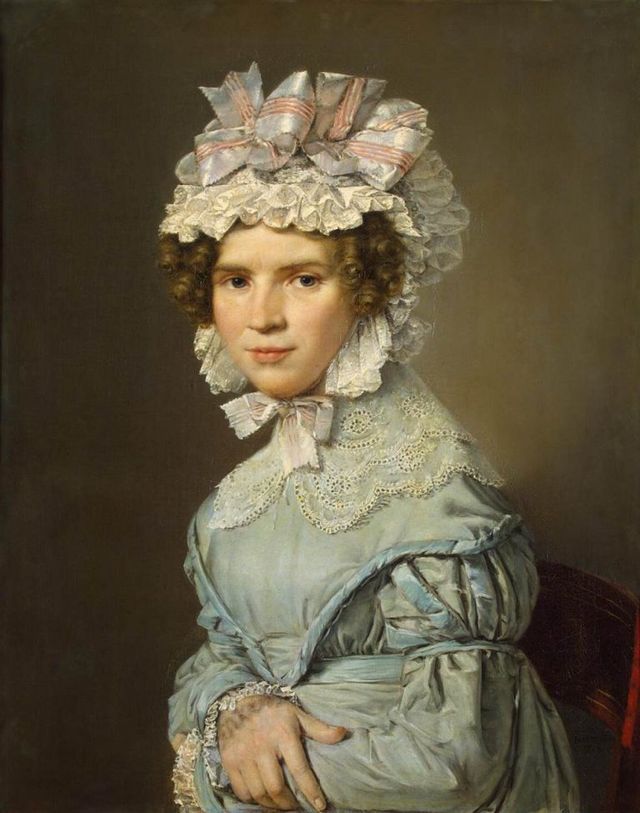 Portrait of a Lady in a Blue Dress by Christian Albrect Jensen, 1824
Portrait of a Lady in a Blue Dress by Christian Albrect Jensen, 1824
By 1840, styles in caps had changed yet again, in large part to accommodate the early Victorian hairstyles. According to The Ladies’ Cabinet of Fashion from 1840:
The caps (if caps they may be called) are composed of lace lappets of a large size: one is attached on each side of the front hair and tastefully intermingled with a sprig of flowers, which droops over it; there is no caul, consequently while these pretty coiffures ornament the hair in the most graceful style; they also display it in all its luxuriance.
This new style, with its large lappets hanging down on either side of the head, scarcely resembled the simple mob caps of the early 19th century (which were now worn mainly by female servants). It was nonetheless popular. In an 1844 issue of Littell’s Living Age, a poem titled “The Song of the May Fashions” referenced these stylish caps in the most flattering language. An excerpt reads:
Say, first what cap shall head of beauty wear,
Though seldom cap should be admitted there.
Tulle chiffonée, with heather blossoms gay,
Or any other tiny flowers of May.
Plain on the forehead are the caps in vogue,
A matron’s air they give each charming rogue;
Broad at the back a pretty curtain placed
With flowery wreath is elegantly graced
And where on each side at the ear it closes,
Deck it with bunches of the same small roses;
Or place a point, with fluted tulle, surrounded,
Or with raised lappets, “à la paysanne” bounded,
And held in bonds of double-tinted gauze,
Lest in “the pride of place” it break through Fashion’s laws.
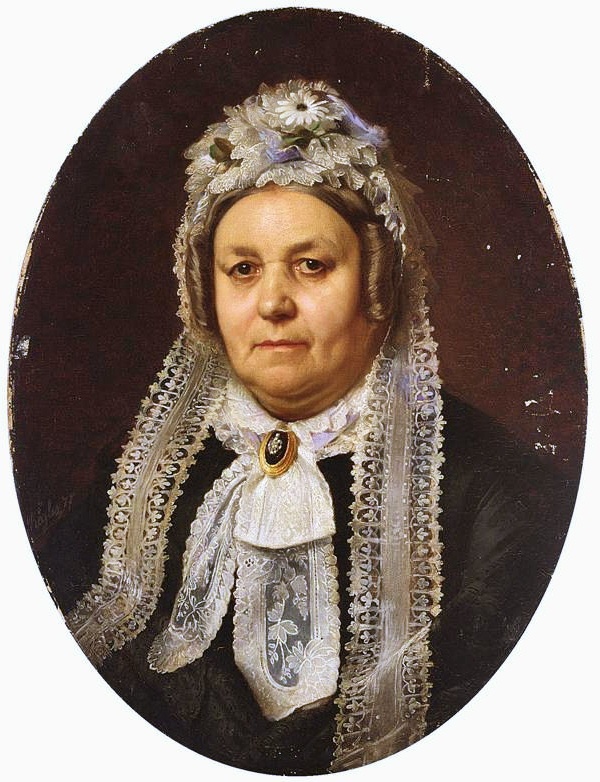 Woman in Black Dress and Lace Cap, mid-19th century
Woman in Black Dress and Lace Cap, mid-19th century
Flowers as decoration remained popular throughout the decade, as did the ever popular blond lace. An 1846 issue of La Belle Assemblée declares:
The prettiest caps for very youthful matrons are of a very small size; they are composed of rows of blond or lace, each divided by a very small wreath of red clematis: this style of garniture has the effect of the hair being strewed with flowers.
By the next decade, the caps for evening dress had become even busier. They were now comprised of a combination of many different materials. As Blackwood’s Lady Magazine of 1857 reports:
One is composed of blonde, chequered with rows of narrow cerise-colour velvet; it is trimmed with quillings of blonde and loops and ends of velvet. A cap composed of frills of white blonde and black lace, is very tastefully trimmed with loops of amber-colour ribbon. This cap has flowing strings of amber-colour ribbon, and a large bow of the same is placed at the back, above the curtain.

Caps of the late 1860s were a bit simpler. The following illustrations from an 1867 issue of Harper’s Bazaar show a dress cap and a breakfast cap. The dress cap (figure 1) is composed of puffed muslin mounted lace and:
The crown simulates a single puff, and is encircled with mauve ribbon, and trimmed with bows on the front and back. The whole cap is bordered with guipure lace and narrow mauve ribbons, the ends of which form strings, and are tied beneath the chignon.
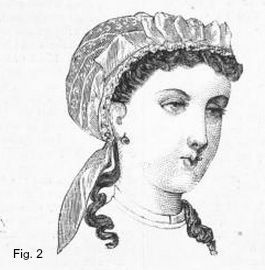
The breakfast cap (figure 2) is described as being “peasant” style. The description reads:
This cap is composed of a large crown, made of guipure insertion, and a small border trimmed with narrow guipure. The border is trimmed in front with loops of blue ribbon set on similar ribbon laid flat, and the ends of which form strings that tie behind.
The trend for simpler styles in caps continued into the middle of the next decade. Godey’s Lady’s Book of 1870 describes a “small lace cap, trimmed with rose-colored ribbon.” Smaller still, they report a coiffure accented with nothing more than a “small fancy piece” of Valenciennes lace and green satin ribbon. Morning caps, however, sound little different from earlier decades. Godey’s describes a simple morning cap of muslin, trimmed with lace and “cherry-colored ribbon” which one can imagine as easily on the head of Jane Austen’s Mrs. Bennet as covering the Victorian curls of Elizabeth Gaskell’s Mrs. Hale.
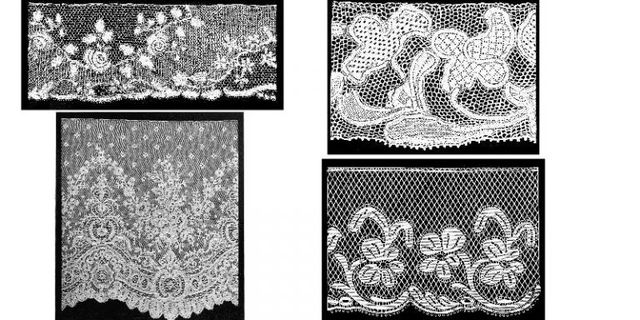 Clockwise from Top Left: Brussels Lace, 1875-76; Guipure Lace, 1875-76; Valenciennes Lace, 1875-76; and Mechlin Lace, 1903.
Clockwise from Top Left: Brussels Lace, 1875-76; Guipure Lace, 1875-76; Valenciennes Lace, 1875-76; and Mechlin Lace, 1903.
 An example of Blonde Lace , France, 1830s. (Image Courtesy of The Museum of Fine Arts, Boston.)
An example of Blonde Lace , France, 1830s. (Image Courtesy of The Museum of Fine Arts, Boston.)
Looking at the trends of the first three quarters of the century, it is little surprise that The Warehousemen and Drapers Trade Journal of 1876 declares blond lace to be “particularly admired at the present moment.” They also describe, in some detail, the desired composition of shapes, fabrics, and colors in caps – as well as inadvertently revealing their new demographic:
Old ladies’ caps are now exactly the shape of young ladies’ bonnets known as Bébé bonnets, only, instead of being made of velvet, or any other thick material, they are made of white, black, and ecru lace…Ecru lace caps are considered to be the most dressy of all. It is almost sufficient to wear a little ecru on the head to be in full and elegant toilette.
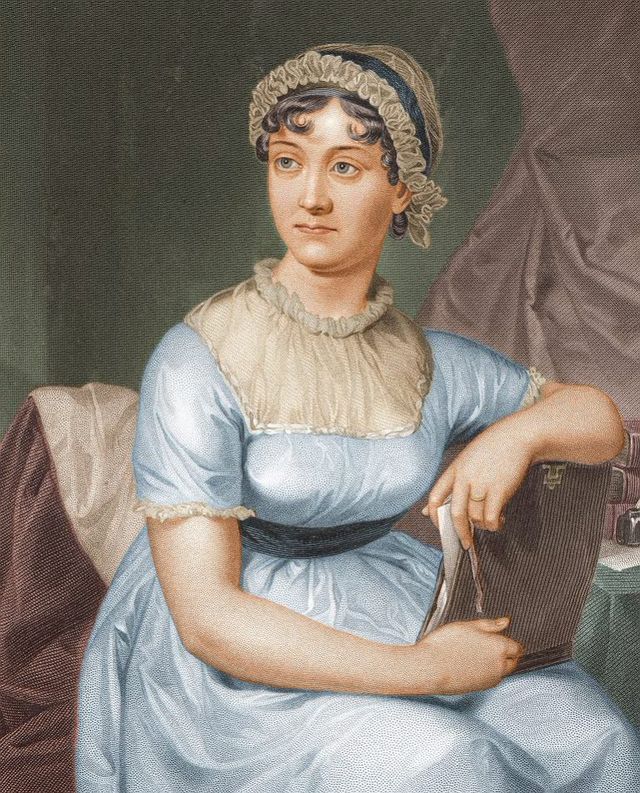 Jane Austen wearing Cap. (Colorized version of a posthumous engraving published in the 1869-70 Memoir.)
Jane Austen wearing Cap. (Colorized version of a posthumous engraving published in the 1869-70 Memoir.)
The reference to “old ladies’ caps” is indicative of the changing fashions. No longer was a lace cap de rigueur for young matrons and spinsters. Instead, by the early 1890s, day caps were largely worn only by the elderly. At the close of the century, even bonnets were beginning to fall by the wayside. As fashion historian C. Willett Cunnington writes, “The bicycle also helped to destroy the bonnet which was becoming more and more the headgear of the elderly.”
Caps were seen throughout most of the 19th century. Whether on a young spinster or an old maid, a newly married lady or an elderly dowager, the cap was a symbol of that stage of female existence when frivolous youth had passed and sober adult living had begun. Such a garment could easily have ended up a sad, drab bit of fabric which robbed its wearer of her femininity and youthful charms. Instead, the 19th century cap was an imminently stylish accessory, the beauty of which owes as much to women’s innate ingenuity as it does to fashion.
Top image: Louise de Guéhéneuc, duchesse de Montebello by Pierre-Paul Prud’hon, early 19th century.
More from BUST
This 19th Century Writer Put His Hatred Of Cats Into A Science Book
The Rats, Cats, And Mice Of 1860s Ladies’ Hairstyles

